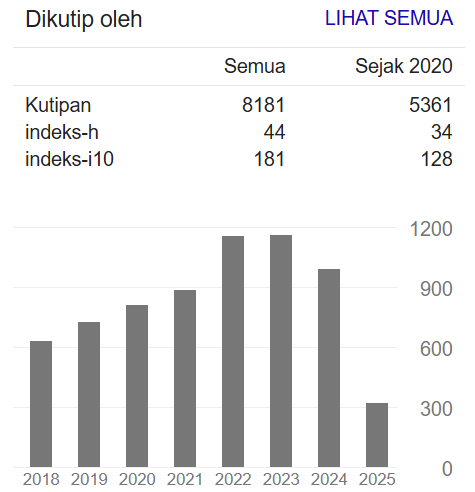OPTIMAL COMBINATION OF TOLUENE AND CLOVE OIL (Syizigium aromaticum) IN THE PROCESS OF CLEARING THE PERMANENT PREPARATION PEDICULUS HUMANUS CAPITIS
DOI:
https://doi.org/10.34011/jmp2k.v34i2.2006Keywords:
clearing, clove oil (Syizigium aromaticum), Pediculus humanus capitis, permanent preparation qualityAbstract
Clearing is a vital process in microscopy, aimed at enhancing the transparency of tissue preparations for clearer observation of insect structures. Despite its effectiveness, Toluene poses safety concerns due to its explosive nature. Therefore, clove oil (Syzygium aromaticum) has been explored as a safer alternative. This study evaluates the quality of permanent preparations of Pediculus humanus capitis using both toluene and clove oil. Comparative tests were conducted, treating adult head lice specimens with each solvent for three repetitions. Permanent preparations were assessed for clarity, color quality, and morphological integrity. Results indicate a significant difference in quality between the two methods. Toluene yielded mainly poor-quality preparations, while clove oil resulted in a higher proportion of preparations of good quality. The Mann-Whitney test confirmed the significance of this difference (p = 0.002). This study highlights the efficacy of clove oil as a safer alternative to toluene in the clearing process, contributing to entomological practices and chemical safety.
References
F. Septiani, “Perbedaan Kualitas Preparat Permanen Pediculus Humanus Capitis Pada Proses Clearing Menggunakan Xylol Dan Minyak Cengkeh.” Universitas Muhammadiyah Semarang, 2018.
F. Azim and N. Andrini, “Perbandingan Angka Kejadian Pedikulosis Kapitis Antara Anak Laki-Laki Dengan Anak Perempuan di Pondok Pesantren Al-Kautsar Al-Akbar Medan,” J. Ibnu Sina Biomedika, vol. 2, no. 1, pp. 72–79, 2018.
A. Iswara and F. Nuroini, “Variasi Konsentrasi Koh Dan Waktu Clearing Terhadap Kualitas Preparat Awetan Pediculus humanus capitis,” in Prosiding Seminar Nasional & Internasional, 2017, vol. 1, no. 1.
G. Purnasari, D. Briawan, and C. Dwiriani, “Asupan Kalsium Dan Tingkat Kecukupan Kalsium Pada Ibu Hamil Di Kabupaten Jember,” Media Kesehat. Masy. Indones. Univ. Hasanuddin, vol. 12, no. 4, pp. 261–268, 2016.
B. Nurhayati, S. Darmawati, and P. P. S. D. M. Keseahatan, “Bahan Ajar Teknologi Laboratorium Medis (TLM): Biologi Sel dan Molekuler.” Pusat Pendidikan SDM Kesehatan Badan PPSDM Kesehatan, Kemenkes RI, 2018.
L. R. Hasanah, “Pengaruh Pemberian Filtrat Buah Murbei (Morus alba L) sebagai Pewarna Alternatif terhadap Kualitas Preparat Gosok Tulang Femur Kelinci (Oryctolagalus cuniculus L).” Universitas Muhammadiyah Malang, 2019.
A. Damayanti and S. Bariroh, “PENGOLAHAN BIJI MAHONI (Swietenia Macrophylla King) sebagai Bahan Baku Alternatif Biodiesel,” J. Bahan Alam Terbarukan, vol. 1, pp. 9–12, 2012, [Online]. Available: https://journal.unnes.ac.id/nju/index.php/jbat/article/view/2539/2592.
R. Kandyala, S. P. C. Raghavendra, and S. T. Rajasekharan, “Xylene: An overview of its health hazards and preventive measures.,” J. Oral Maxillofac. Pathol., vol. 14, no. 1, pp. 1–5, Jan. 2010, doi: 10.4103/0973-029X.64299.
J. M. Clark, “New chemistries for the control of human head lice, Pediculus humanus capitis: A mini-review,” Pestic. Biochem. Physiol., vol. 181, p. 105013, 2022.
J. N. Haro-González, G. A. Castillo-Herrera, M. Martínez-Velázquez, and H. Espinosa-Andrews, “Clove essential oil (Syzygium aromaticum l. myrtaceae): Extraction, chemical composition, food applications, and essential bioactivity for human health,” Molecules, vol. 26, no. 21, 2021, doi: 10.3390/molecules26216387.
J. K. Straughen et al., “The Impact of Environmental Benzene, Toluene, Ethylbenzene, and Xylene Exposure on Blood-Based DNA Methylation Profiles in Pregnant African American Women from Detroit,” Int. J. Environ. Res. Public Health, vol. 21, no. 3, 2024, doi: 10.3390/ijerph21030256.
R. Tsamiya et al., “Comparative Evaluation of Clove, Olive and Groundnut Oil’s Clearing Ability in Tissue Processing,” J. Med. Lab. Sci., vol. 31, pp. 43–53, Mar. 2021, doi: 10.5281/zenodo.4641412.
N. Azizah, E. Y. Mahtuti, and Faisal, “Fixation Process With 10% KOH Immersion And Variation Of Heating Temperatures On The Quality Of Pediculus humanus capitis,” Medicra (Journal Med. Lab. Sci., vol. 5, no. 2, pp. 80–85, 2022, doi: 10.21070/medicra.v5i2.1635.
A. Damayanti, B. Triwibowo, M. Megawati, A. T. Ekanuramanta, H. Harianingsih, and K. Thomas, “Optimization of The Aqueous Enzymatic Extraction (AEE) of Rice Bran Oil With Cellulase Using Response Surface Methodology,” J. Bahan Alam Terbarukan, vol. 12, no. 1, pp. 87–96, 2023.
B. Sadanandan et al., “Aqueous spice extracts as alternative antimycotics to control highly drug resistant extensive biofilm forming clinical isolates of Candida albicans,” PLoS One, vol. 18, no. 6, p. e0281035, 2023.
A. Ghofur, T. Suparyati, and A. Qolbi, “Pengaruh Variasi Waktu Clearing (Penjernihan) Toluene Terhadap Kualitas Sediaan Permanen Cimex lectularis,” J. Med. Husada, vol. 2, no. 1, pp. 29–34, 2022.
I. P. D. K. Yadnya, F. Azmi, A. Andriana, and A. V. W. Taufiq, “Efektivitas Kombinasi Ekstrak Daun Jeruk Nipis dan Perasan Buah Jeruk Nipis (Citrus aurantifolia) terhadap Mortalitas Kutu Rambut (Pediculus humanus var capitis),” Nusant. Hasana J., vol. 2, no. 11, pp. 101–111, 2023.
R. Shalsadila, M. Nuryanti, and P. Purwaeni, “Review Artikel: Potensi Berbagai Bahan Alam Sebagai Insektisida Alami Kutu Rambut (Pediculus humanus capitis),” J. Pharm. Sci., vol. 6, no. 2, pp. 664–672, 2023.
P. Bauer and A. Buettner, “Quantification of odorous and potentially harmful substances in acrylic paint,” Ecotoxicol. Environ. Saf., vol. 262, p. 115329, 2023.
A. Putri, Y. S. Mulia, S. Sulaeman, and W. Wiryanti, “Pengaruh Variasi Waktu Perendaman dengan Alkohol terhadap Kualitas Preparat Permanen Larva Culex sp,” J. Kesehat. Siliwangi, vol. 4, no. 1, pp. 340–345, 2023.
S. Aisyah, E. Y. Mahtuti, M. Masyhur, and F. Faisal, “Perbandingan Penggunaan Pelarut Organik Xilene Dengan Toluena Pada Tahapan Clearing Terhadap Kualitas Preparat Aetan Aedes Albopictus (Stegomyia albopictus),” Anakes J. Ilm. Anal. Kesehat., vol. 9, no. 1, pp. 20–27, 2023.
E. Abbasi et al., “Evaluation of resistance of human head lice to pyrethroid insecticides: a meta-analysis study,” Heliyon, vol. 9, no. 6, 2023.
N. C. for B. Information, “PubChem Compound Summary for CID 1140, Toluene,” National Center for Biotechnology Information, 2024. .
M. A. Muwaffaq and E. Supriyo, “Optimization of clove flower oil extraction (Syzgium aromaticum L.) With Factorial Design Method,” J. Vocat. Stud. Appl. Res., vol. 3, no. 2, pp. 38–41, 2021, doi: 10.14710/jvsar.v3i2.12182.
N. Alwahaibi, S. Aljaradi, and H. Alazri, “Alternative to xylene as a clearing agent in histopathology.,” J. Lab. Physicians, vol. 10, no. 2, pp. 189–193, 2018, doi: 10.4103/JLP.JLP_111_17.




